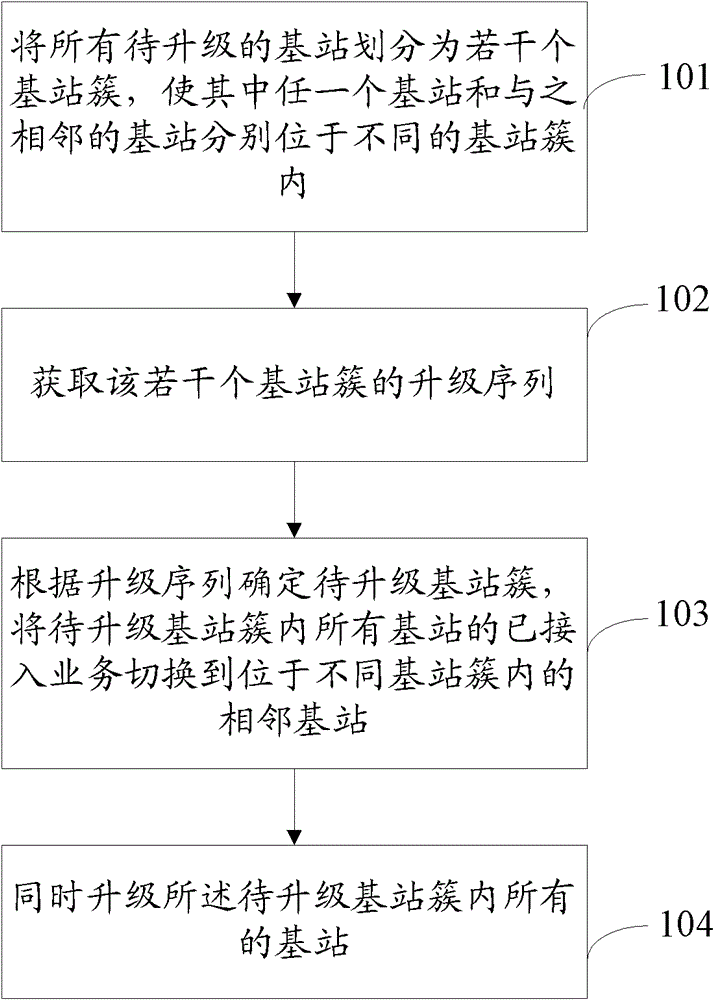Method and system for upgrading base stations in batches
A technology of batch upgrade and base station, applied in the field of communication, which can solve the problems of inaccessibility of new services and interruption of services.
- Summary
- Abstract
- Description
- Claims
- Application Information
AI Technical Summary
Problems solved by technology
Method used
Image
Examples
Embodiment 1
[0022] Please refer to figure 1 , this embodiment provides a method for upgrading base stations in batches, including steps:
[0023] 110. The EMS divides all base stations to be upgraded into several base station clusters, so that any base station and its adjacent base stations are respectively located in different base station clusters.
[0024] The division principle of the base station cluster is: divide the adjacent base stations that can switch services between each other into different base station clusters as much as possible. The specific division strategy is: divide any base station and several adjacent base stations into different base station clusters. within the cluster.
[0025] 120. The EMS acquires the upgrade sequences of the several base station clusters;
[0026] EMS can randomly determine the upgrade sequence of each base station cluster by itself, or determine the upgrade sequence of each base station cluster according to the preset strategy, and can als...
Embodiment 2
[0035] In this embodiment, step 110 may have several preferred solutions.
[0036] In a preferred solution, step 110 may specifically include the steps of:
[0037] 111. The EMS obtains the neighbor cell relationship list and traffic statistics data of the base station to be upgraded, and the traffic statistics data includes the number of service handovers and handover success rates between any base station and its adjacent base stations within a preset time.
[0038] In this step, the EMS collects and obtains the data required for base station cluster division, including: a. Obtaining the statistics data of all base stations to be upgraded, including the number of handovers and handover success rates of services between adjacent base stations; b. Obtaining all base stations to be upgraded c, data merging processing, the neighboring cell relation list and the traffic statistics data are merged to build a data structure, which is jointly used as the basis for base station clust...
Embodiment 3
[0047] In this embodiment, step 130 may have several preferred solutions.
[0048]In a preferred solution, in step 130, the step of switching the accessed services of all base stations in the base station cluster to be upgraded to adjacent base stations located in different base station clusters may specifically be:
[0049] Gradually reduce the power of all base stations in the base station cluster to be upgraded, so that all accessed services of the base station cluster to be upgraded are spontaneously switched to adjacent base stations located in different base station clusters.
[0050] In this preferred solution, the EMS gradually reduces the power of the base station. When the power of the base station is lower than the power of its adjacent base station, the user's already accessed service will be switched to the adjacent base station spontaneously, and the base station will no longer access new business. This preferred solution is simple to implement.
[0051] In ano...
PUM
 Login to View More
Login to View More Abstract
Description
Claims
Application Information
 Login to View More
Login to View More - R&D
- Intellectual Property
- Life Sciences
- Materials
- Tech Scout
- Unparalleled Data Quality
- Higher Quality Content
- 60% Fewer Hallucinations
Browse by: Latest US Patents, China's latest patents, Technical Efficacy Thesaurus, Application Domain, Technology Topic, Popular Technical Reports.
© 2025 PatSnap. All rights reserved.Legal|Privacy policy|Modern Slavery Act Transparency Statement|Sitemap|About US| Contact US: help@patsnap.com



